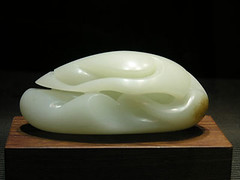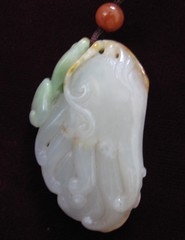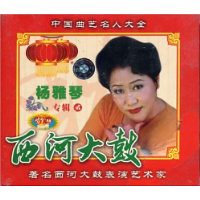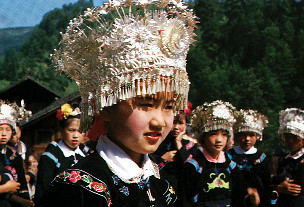| Home > Living in China > Art |
China Jade History
 |
The Chinese regard carved jade objects as intrinsically valuable, and they metaphorically equate jade with human virtue due to its solidity, durability and (moral) beauty.
Many countries boast a jadeware culture, but none of them can match China's long jadeware history. In China, jadeware underwent a long process of development beginning from the New Stone Age 10,000 years ago.
The earliest jadeware found in China was a piece of serpentine stoneware unearthed at the Immortal Cave in Haicheng, Liaoning Province, dating back more than 12,000 years. The second was a small hanging jade article excavated at Hemudu in Zhejiang Province dating back more than 7,000 years. Jadeware from that period was mainly used for personal decoration. A large number of exquisite jade objects were produced 4,000 years ago. At the time, jadeware was mainly used for witchcraft and as an emblem of privilege.
During the Shang Dynasty (1600-1100BC,) craftsmen used metal tools to make progress in jadeware models and sculpture. Round jade articles increased in large numbers and jadeware was often given as a gift.
The jade-carving technique was developed quickly in the Spring and Autumn and Warring States periods (770-221BC.) The Spring and Autumn Period was known for its well-carved and exquisite jadeware. The coherent and undulating patterns of the dragon, phoenix and Panli (a figure of Chinese folklore) on the jade decorations are still treasured today.
 |
During the Qin and Han dynasties (221BC-AD220), jadeware became more practical and objects such as jade tablets became obsolete. At that time, people began to believe in the power of jadeware to increase longevity: They thought they would live forever like gods if they possessed jadeware. Therefore, the practice of burying the dead with jadeware became common. Invaluable jade figures and clothes sewn with golden thread have been found in tombs dating back to the Han Dynasty.
During the Three Kingdoms (AD220-280) until the Song and Yuan dynasties (960-1368), there were no great developments in jade carving. This changed in the Ming Dynasty (1368-1644) when many famous craftsmen emerged. White jade vessels with golden holders and white jade bowls with golden lids, which were unearthed in the Ming Tombs, reflected the dynasty's peak level in jade carving. The jadeware technique peaked during the Qing Dynasty (1644-1911) under the advocacy of Emperor Qianlong.
The patterns of China's jadeware have rich connotations, revealing strong, auspicious colors. Bats and gourds were used as subjects for more than 100 patterns because the Chinese words "bat" and "gourd" sound like "good fortune" in Chinese. When a bat was carved on an ancient coin with a hole, it meant that fortune was at hand; bats coupled with birthday peaches referred to fortune and longevity; bats mixed with sika, birthday peaches and magpies were also considered good omens. These beliefs reflected the ancient Chinese people's yearning for a happy life and revealed the essence of China's traditional culture.
Jade in China is varied and can be divided into two categories: hard and soft jade. Good materials provide a strong basis for jadeware carving, but the value of a jade object depends on the skills and reputation of the craftsman, date of carving, peculiar modeling and the owner's status. Certainly, different people will have various views on the value of the same jade object. It is difficult to have a unanimous standard. Due to the high value of ancient jadeware, there is an equally long tradition of fake jadeware, which looks very much like the real thing. Jadeware collectors should be careful and seek the opinions of professionals before making any major purchases.
Art
 more
moreChina Jade History
The Chinese regard carved jade objects as intrinsically

Chinese Traditional Art---- Xihe
Famous Star of Xihe Dagu---Yangyaqin Xihe

The Romance of butterfly lovers

Customs
 more
more



 print
print  email
email  Favorite
Favorite  Transtlate
Transtlate 
